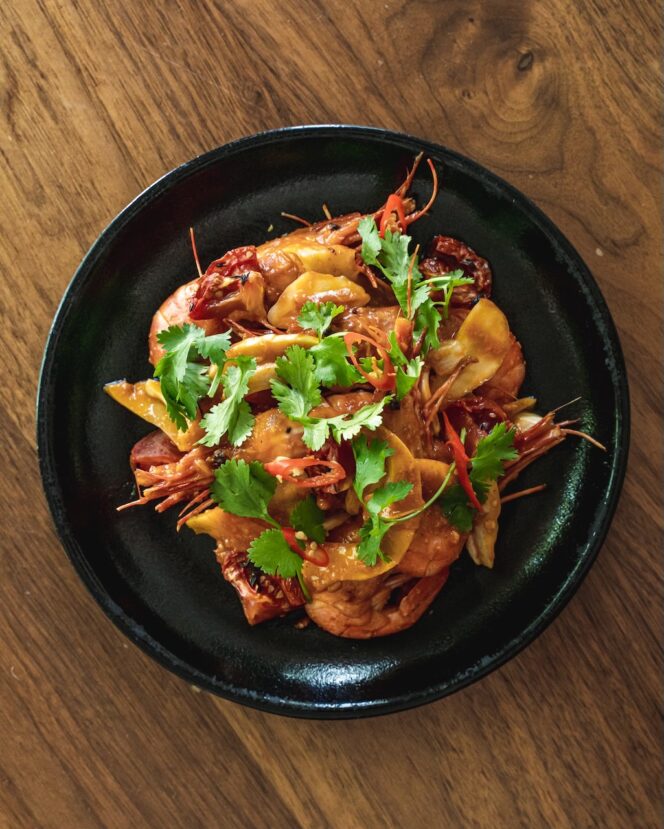
PiDGiN – Local spot prawns, shoaling ketchup, garlic butter, and confit tomatoes; Photo: Juno Kim
“Growing up in Vancouver, I came into contact with all the different cuisines that Vancouver has to offer,” says Wesley Young, Executive Chef at PiDGiN. His parents, who had immigrated from Guangzhou, China, ran a produce store in East Vancouver, selling spinach to Indian temples, and rapini and fennel to the Italian families in the neighbourhood. Young would often go through the back door of the Korean restaurant next door to fuel up for lunch.
This early exposure to diverse cuisines established a base sensibility that Young would draw upon as he developed as a chef. After training at Malaspina University College and Vancouver Community College in primarily French-European technique, Young gained a wealth of experience cooking both locally, nationally, and internationally.
His impressive resume includes working at London’s Four Seasons Hotel Park Lane and Tom Aikens Restaurant; 357C, an exclusive private club in Montreal; and some of the top restaurants in Vancouver, such as the former West Restaurant, C Restaurant, and Wildebeest. Especially at the Four Seasons in London, Young interacted with a multicultural mix of chefs and staff from places like Germany, Indonesia, Australia, and South Africa.
All these culinary influences intersect as Young crafts dishes at PiDGin. He explains that “fusion” cooking became trendy in Vancouver around 20 years ago. “Back then, it might have been wasabi mayonnaise on a dish,” says Young. He says that fusion got a bad rap, associated with “a mixed bag of things, or a buffet of disparate elements that don’t make that much sense.”
Young continues that pan-Asian cuisine overlaps with fusion cuisine but has become, particularly at PiDGiN, a much more refined type of cooking that blurs culinary boundaries with subtlety: “It’s past that version. I think as time has evolved, our combination of western techniques and Asian flavours, or vice versa, isn’t as obvious as that initial version of Asian fusion you would have got twenty years ago.” Instead, the dishes at PiDGiN evidence a sophisticated melding of East and West that is a product of a careful attention to flavour, technique, and quality of ingredients – many of which are locally sourced. In some cases, dishes will be entirely Asian, and in other cases, entirely French-influenced. There is no formula per se; it’s whatever makes the most sense on the palate.
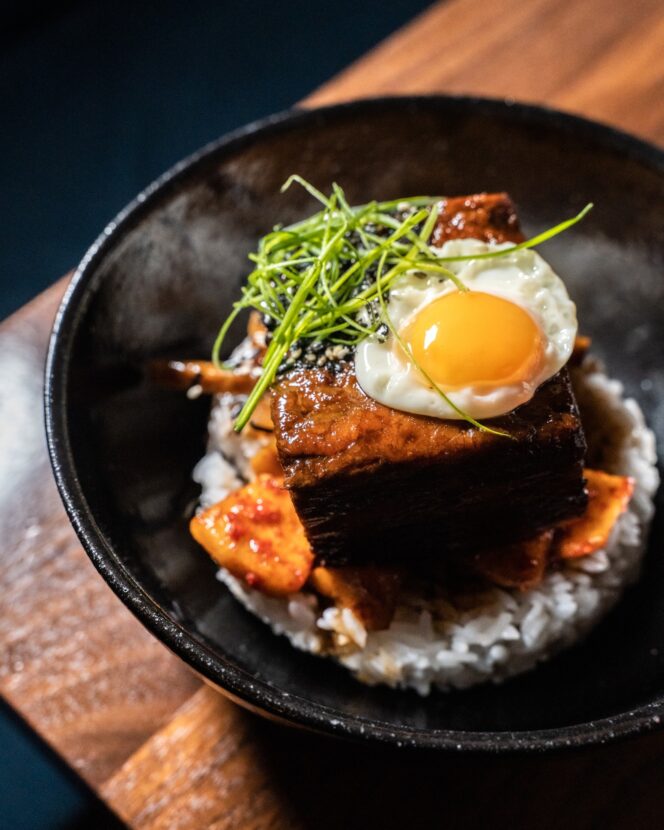
Pork belly rice bowl; Photo: Juno Kim
Plates range from rotating sashimi with raw cucumber, compressed grapefruit segments, shiso, and shoyu ponzu, to a pork belly rice bowl with Asian pear kimchi, bamboo, and fried quail egg. Young explains that the kitchen once did a play on linguine vongole using udon and adding shiso for a bright herbal flavour note. “That dish was done in a way so every step made sense. It’s not just a simple subbing out of one element for another, like shiso for basil. You have to consider if the flavours actually marry well together,” says Young.
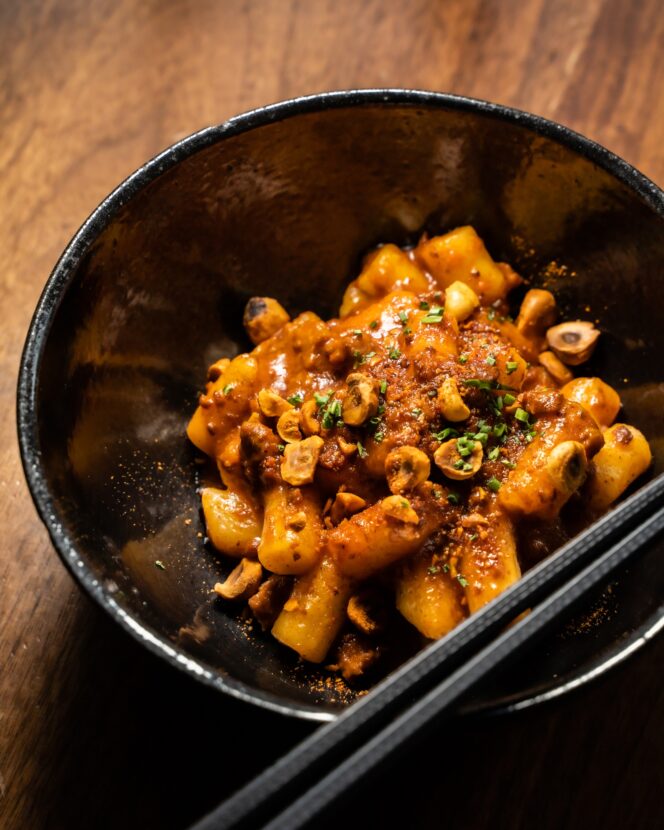
PiDGiN’s Korean rice cakes with gochujang bolognese and spiced hazelnuts; Photo: Juno Kim
One of the restaurant’s most enduringly popular dishes brings together Korean and Italian elements to celebrate the rustic elements of both cuisines. “We all know spaghetti bolognese. We all know gnocchi. These are two super approachable and comforting dishes for our North American palate,” says Young. Korean rice cakes stand in place of gnocchi, while the slow cooked bolognese is amped in flavour with gochujung (Korean chili paste). The dish is finished with toasted hazelnuts dusted with hondashi (instant bonito fish stock) and paprika for a final umami flavour bomb.
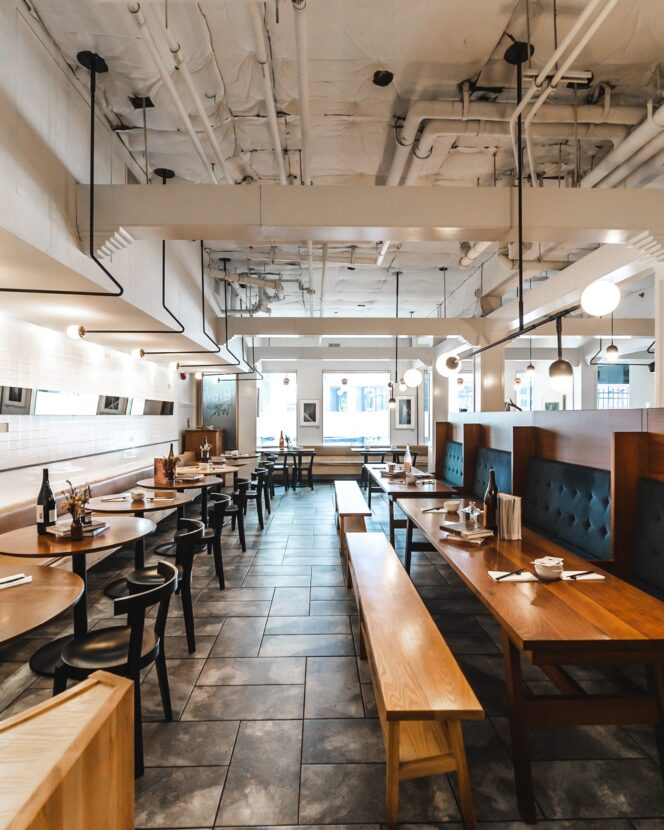
Photo: Juno Kim
Young says the restaurant’s location in Vancouver makes it particularly well suited to a hybrid Asian cuisine. “We’re on the edge of Gastown. We’re a block away from Chinatown. The historic Japantown and Railtown are two, three blocks from us. If we look at historic geography, we’re at that nexus. I think that’s also a reflection of what we do,” says Young.
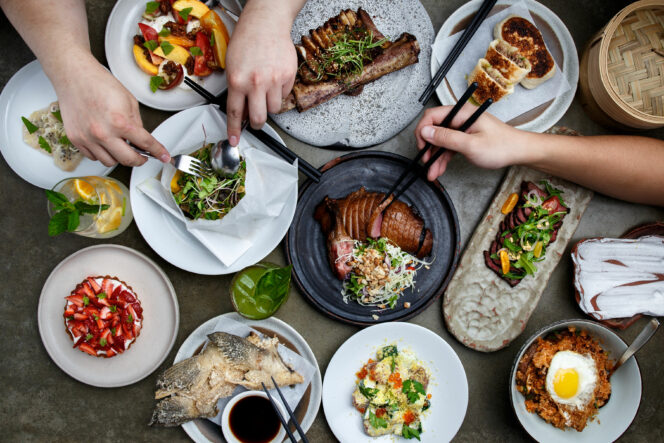
Torafuku’s 6th anniversary dinner menu; Photo: Leila Kwok
The cuisine at Torafuku, situated in Chinatown, is also a reflection of its historic location, as well as the demographic makeup of the city. Steve Kuan, chef and owner, describes his restaurant’s interpretation of pan-Asian cuisine: “I think pan-Asian is creating Asian dishes using west coast ingredients but at the time with some Asian ingredients as well.” Kuan says that, for him, pan-Asian cuisine is very similar to fusion cuisine but because of the negative associations with the word “fusion,” it’s fallen out of use. Nonetheless, both refer to a type of cooking that draws upon multiple Asian culinary traditions, with some Western influence. “We don’t limit ourselves. It’s pretty much all the Asian aspects, like Chinese, Japanese, Thai. All those flavours can be incorporated into our food,” he says.
Like PiDGiN, Torafuku prioritizes ingredients from local farms and producers, like Sole Food Farms, Mikuni Wild Harvest, Hannah Brook Farm, and Barnston Island Herbs. As a result, the menu shifts with the seasonality of ingredients, making it rooted in the west coast, even as it reinterprets Asian recipes and flavour combinations.
Kuan’s early years in Taipei, Taiwan, inspire much of the dishes that he crafts. “The food that we create a lot of times reflects my home town street food. We give the street food dishes a different look and taste,” says Kuan. His food truck, Le Tigre, spotlights this reinvented street food by serving crispy chicken with Thai chili, and 7 spice mayo, as well as pork and shrimp dumplings with mixed herb salad with chili soy dressing, pickled radish, and seaweed flakes.
At Torafuku, Kuan explains that their pan-Asian cuisine has evolved since the restaurant first opened in 2015, taking on a simplified confidence. “We don’t like to complicate the plates. We let the food speak for itself, so we use the best ingredients we can get. We have more natural flavours instead of a lot of flavours masking the original ingredients,” says Kuan.
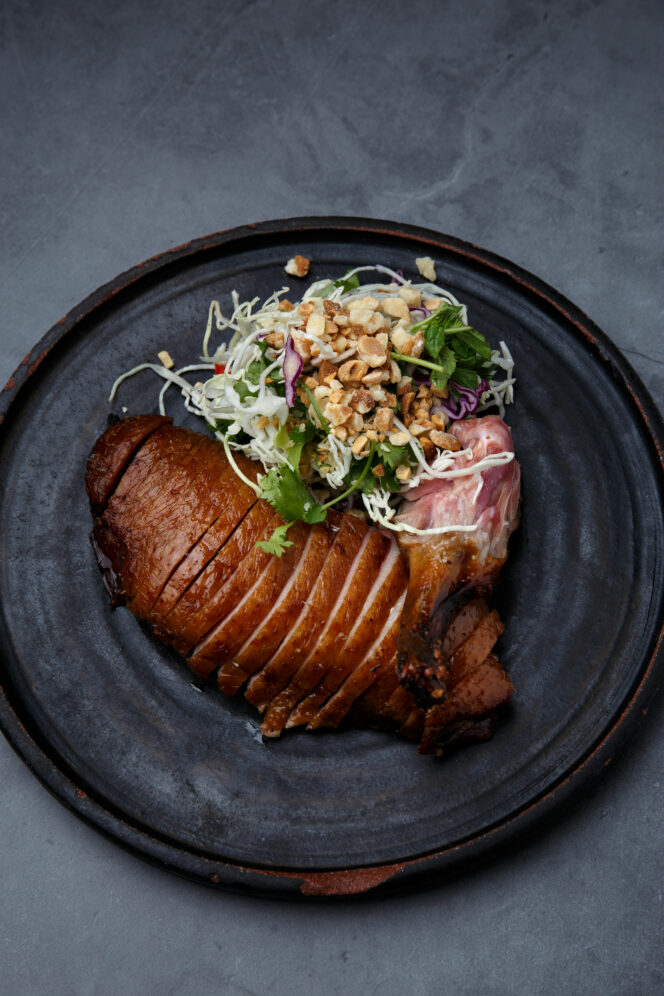
Brome Lake duck breast; Photo: Leila Kwok
The restaurant currently features a roasted Brome Lake duck breast that was inspired by Peking Duck. The duck is blanched in a flavourful stock, dry aged, and then roasted at a high temperature when a customer orders the dish. The rub is a familiar Chinese five-spice combination, with spices like cinnamon and star anise. Meanwhile, the coleslaw brings in other Asian flavours. “The coleslaw flavours are more Thai. It’s got fish sauce, lime juice, and candied peanuts with some Thai basil. The flavours are really well balanced,” says Kuan.
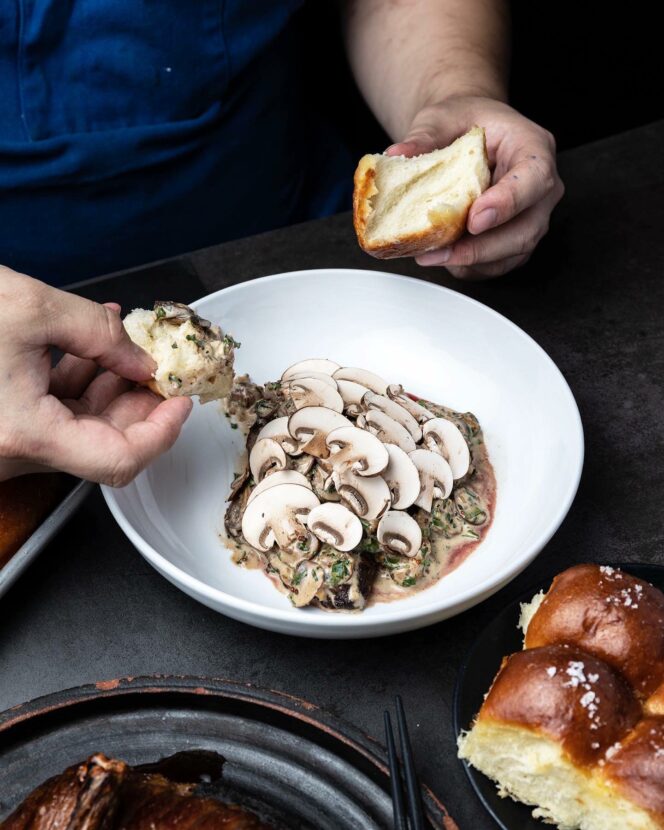
Milk bread with Steak Diane; Photo: Leila Kwok
Torafuku also does a take on Steak Diane, with Cache Creek picanha (sirloin cap) oven roasted, and served with a brandy Worcestershire sauce with tarragon, parsley, thyme, and mixed mushrooms, such as shiitake. The steak is accompanied by a Japanese milk bun (pain au lait), which is made in-house. “It got really popular in Taiwan a couple year ago,” says Kuan. Kuan wanted the milk bun to be eaten with the Steak Diane to add a Taiwanese twist to what, on the surface, appears like a classic Western dish.
Both Kuan and Young are extremely passionate about the possibilities of bringing together different Asian and Western food traditions in a way that is educated and thoughtful. The plates that both restaurants produce speak to Vancouver, a city that a host of different people and food cultures call home.
















